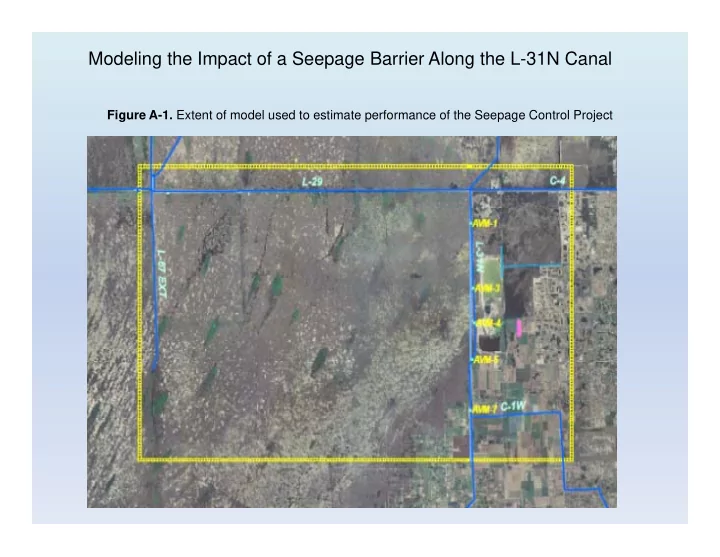

Modeling the Impact of a Seepage Barrier Along the L-31N Canal Figure A-1. Extent of model used to estimate performance of the Seepage Control Project
Table A ‐ 1. Model Layering and Hydraulic Conductivity Thickness Thickness Thickness Thickness Horizontal Horizontal Vertical Vertical Model d l Bottom Elev l at L ‐ 31N at L ‐ 67ext Note Conductivity Conductivity Layer (ft NGVD) (ft) (ft) (ft/d) (ft/d) Land 1 NA NA Wetland layer 2.0E+07 2.0E+06 Surface Surface 2 5.00 Variable Variable Muck layer 150 150 Flow Zone 1 (Miami 3 ‐ 5.00 10.00 5.65 12,500 1,250 Limestone) 4 ‐ 7.00 2.00 1.13 Hard Layer 1 (Q4) 5 5 Flow Zone 2 (Upper 5 ‐ 9.00 2.00 1.13 25,000 2,500 Ft. Thompson) Flow Zone 2 (Upper 6 ‐ 17.00 8.00 4.52 25,000 2,500 Ft. Thompson) 7 ‐ 19.00 2.00 1.13 Hard Layer 2 (Q3) 5 5 Flow Zone 3 (Middle 8 ‐ 29.00 10.00 5.65 25,000 2,500 Ft. Thompson) 9 ‐ 31.00 2.00 1.13 Hard Layer 3 (Q2) 5 5 Flow Zone 4 (Lower 10 ‐ 41.00 10.00 5.65 25,000 2,500 Ft. Thompson)
Figure A-2. Model grid showing major landscape features.
Figure A-3. Cross section of Model Grid showing major features. Figure A-5. Sketch of flow distribution from L-29 to ENP.
Figure A-4. Location of monitoring well locations used in the analysis.
Figure A-6 . Area within Everglades National Park affected by a 7 mile long, 30 foot deep barrier during a typical wet season (average daily stage data from 7/1/2008 through 10/31/2008).
Table A-2. Aerial extent, in acres, of increased water level in ENP in response to various Table A 2. Aerial extent, in acres, of increased water level in ENP in response to various seepage barrier configurations for a typical wet season. 7 mile 7 mile Barrier 30 Stage 7 mile 7 mile 2 mile 1.5 mile 1 mile Feet Deep Change Barrier 30 Barrier 18 Barrier 30 Barrier 30 Barrier 30 (West Category Feet Deep Feet Deep Feet Deep Feet Deep Feet Deep Wellfield ‐ 40 MGD) .05 ‐ .1 12,242 12,276 10,410 9,537 5,056 1,835 .1 ‐ .2 .1 .2 11,930 11,930 12,076 12,076 4,397 4,397 2,723 2,723 1,311 1,311 213 213 .2 ‐ .3 5,429 5,287 159 415 137 .3 ‐ .4 2,495 , 2,425 , >.4 881 855
Figure A-7. Model Result: Average annual flow diverted south by the L-31N Canal between the Tamiami Trail and G-211. 90 80 70 60 0 Acre ‐ Feet 50 Base Condition Base Condition 1,000 40 40 18 Foot Barrier 30 20 20 30 foot Barrier 10 0 0 Annual
Figure A-8 . Model Result: Average annual flow through the four flow zones at the eastern boundary of ENP with and without a 30 foot deep 7-mile long barrier. eastern boundary of ENP with and without a 30 foot deep 7 mile long barrier.
Figure A-9. The flow transect used for estimating change in sheetflow as a result of the seepage barrier are shown in red.
Figure A-10. Estimated net flow across the transect shown in Figure A-9, with and without the 7-mile, 30 foot deep seepage barrier.
Table A-3. Net change in flow through Northeast Shark River Slough at the transect in Figure A-9, as a percentage of the base flow. Shallow indicates a barrier depth of 18 feet and deep indicates a depth of 30 feet. The numbers following the depth designations refer to the length of the barrier, in miles, from Tamiami Trail to the south. Average Percent Change in Flow for Various Seepage Barrier Configurations Deep-7 Season Shallow-7 Deep-7 Deep-2 Deep-1.5 Deep-1 (40 MGD) Annual 8.7% 27.8% 8.2% 5.8% 3.2% 27.0% N t Net Wet 12.2% 37.5% 11.0% 7.7% 4.4% 36.1% Change for NESRS Dry 5.6% 19.3% 5.6% 4.0% 2.1% 19.0% Annual 1.9% 5.9% 1.9% 1.5% 0.9% 5.8% Change at Wet 2.5% 7.5% 2.4% 2.1% 1.3% 7.4% North- South Transect Dry 1.3% 4.4% 1.4% 1.0% 0.5% 4.3% Annual 6.8% 21.9% 6.3% 4.2% 2.3% 21.2% Change at East-West Wet 9.7% 29.9% 8.6% 5.6% 3.1% 28.7% Transect Dry Dry 4 3% 4.3% 14.9% 14 9% 4 3% 4.3% 3.0% 3 0% 1.6% 1 6% 14 6% 14.6%
Recommend
More recommend